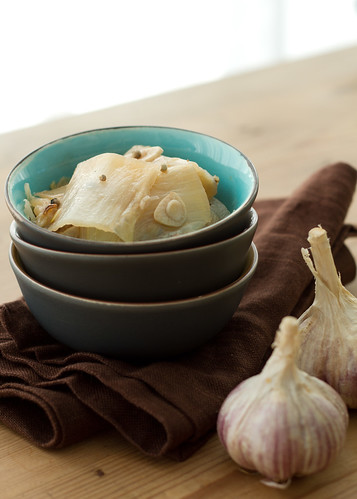
This was originally posted in November 2012. I'm reposting this as it seems like a perfect recipe to share to celebrate the Chinese New Year :)
What do you usually do with a Peking cabbage/Chinese leaves/Chinese celery cabbage/Napa cabbage (Brassica rapa subsp. pekinensis)?
In Estonia you'll most likely to encounter it chopped into small dice or thin ribbons and mixed with chopped peppers, tomatoes, cucumbers, perhaps some feta cheese, and served as a side salad. Not particularly interesting, but cheap and filling.
I hosted/instructed couple of Chinese cookery events earlier this year, and while preparing for the events, I spent hours browsing my favourite Chinese cookbooks, looking for recipes and inspiration. Fuchsia Dunlop and Ken Hom are my favourites for inspiration (currently in love with Dunlop's most recent book, Every Grain of Rice, the US version is due in February), but Yan-kit So's Classic Chinese Cookbook, as well as Sasha Gong and Scott Seligman's The Cultural Revolution Cookbook provided a number of excellent dishes for the final menu.
One of the dishes that I included in the final menu, was this humble braised Chinese cabbage, served hot. This particular recipe is from Ken Hom's wonderfully approachable tome, Complete Chinese Cookbook (hardcover, published in August 2011), with tiniest of modifications (you'll find the original recipe for Braised Beijing (Peking) Cabbage in Cream Sauce on p 264); there are rather similar recipes for braised Chinese leaves in Sasha Gong's book (p 21), and in Yan-kit's book (p 205)).

I was rather sceptical to start with - I had never had these leaves in a hot dish before (and don't care much for the raw version myself). However, this dish was a true revelation - the leaves become almost silky after braising, and the final dish was much bigger that the sum of its parts. As we were enjoying our meal at the end of the 2-hour cooking marathon, most of the participants were expressing their surprise regarding how much they enjoyed this dish, having not had very high expectations about cooking and eating a hot dish using Chinese leaves (and that happened three times, actually, as I hosted three Chinese cooking sessions, all sold out, and all having 15 participants).
Note the dish is gluten-free, and also vegetarian, if you use plain water instead of Chinese chicken stock. Not as flavoursome, but still tasty.
NB! There are few more Chinese recipes here on Nami-Nami.
Braised Peking cabbage in chicken stock
(Hautatud Hiina kapsas leeme sees)
Serves four to six

500 g Chinese leaves
1 Tbsp groundnut oil
3 large garlic cloves, peeled and thinly sliced
300 ml chicken stock (ideally Chinese-style chicken stock)* or water
1 tsp salt
0.5 tsp ground white pepper
To thicken:
2 tsp cornflour + 2 Tbsp water (optional)
Cut the Chinese leaves into 5 cm (2 inch) wide strips.
Heat the wok. Add oil and heat until hot and slightly smokey. Add the garlic, stir-fry for 15 seconds.
Add the cabbage leaves, stir-fry for 2 minutes.
Add the stock or water to the wok, season with salt and pepper.
Reduce heat, cover the pan and simmer on a low heat for 15 minutes, until the cabbage leaves are softened.
Using a slotted spoon, remove the cabbage leaves from the pan and place into a serving dish.
Reduce the remaining liquid by half. Add the cornflour water, heat through to thicken*.
Pour the thickened stock over the cabbage leaves and serve at once.
* To be really honest, I've usually skipped the final thickening phase with cornflour and simply reduced the liquid.
Thank you, Marju, for helping me style this simple dish for the photo shoot.

11 comments:
Pille, you wouldn't recommend some veggie stock as an alternative rather than water?
James, sure, you could use vegetable stock as well. (Reminds me that I've run out of my trusty Marigold and cannot get it here in Estonia. Sulk).
I used to do a salad: cut up chinese leaves, onions, celery stalks and sweet pepper. The dressing is grated horseradish from jar, oil, vinegar and thai sweet chilli sauce all mixed up. Something along these lines was served years ago at Prie parlamento restaurant in Vilnius.
Greetings from Riga!
What's special about "Chinese" chicken stock that it's recommended? Fascinating recipe - wish I were closer to a kitchen!
Anon. from Riga - interesting, that sounds almost like kimchi-analogue?
Alanna, I've been making one like this:
6 drumsticks, 6 wings
3.5 litres of water
a thumb-sized piece of fresh ginger
6 garlic cloves (crush with the blade of your knife)
6 spring onions (white part only)
1 tsp kosher salt
There's a rougher version using chicken pieces and pork pieces, but I've used just chicken.
Pille,
I have never eaten kimchi! But yes, horseradish in that salad dressing really works well. The dressing was really special, never tasted something like that anywhere else.
p.s. Marigold swiss bouillon powder is freely stocked in Riga organic food shops and I think at Stockmann as well.
Pille, you are very welcome!
It's nice that you shared the recipe now, too, because my dad is a big fan of Asian food and I remembered the spark in his eyes, when I had told him about your recipe we photographed together, so thanks! :)
Redhead - interesting - I wonder if our Stockmann stocks it, too? Never noticed it until now, but then I haven't been looking for it either..
Marju - loodan, et Su isale meeldib see roog!!!
I wondered what 'groundnut oil' is & then realized that you meant 'peanut oil'!
Dear Pene, I speak British English, so to speak, and "groundnut oil" is exactly the correct word.
I believe this is known as "peanut oil" in the US and Australia then, and can also be called arachis oil in some parts of the world.
ma ei keedaks kapsast nii pehmeks - piisab juba vokkimisest ning puljongis vaid serveeriks. juurde sobivad hästi seened ja muna.
Post a Comment